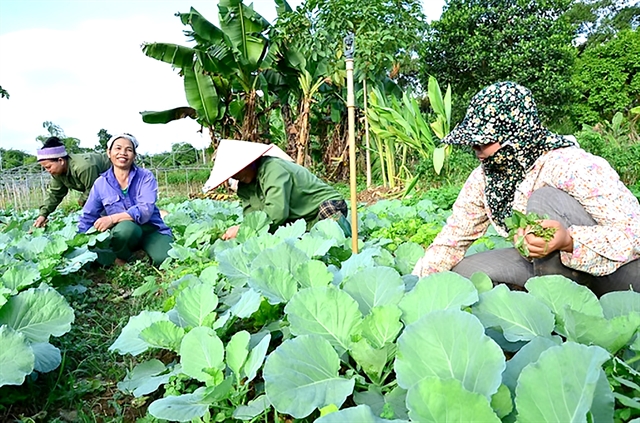 Society
Society

 |
| Farmers of Gừa hamlet organic farming group take care of the vegetables in their garden in northern Hòa Bình Province. — Photo nongnghiep.vn |
HÀ NỘI — After decades of pursuing organic agriculture, farmers have started to see the industry grow as the result of their hard work. However, they still have a long road ahead before organic produce is widely accepted.
Hoàng Bích Thùy, head of an organic farming group in northern Hòa Bình Province, said that not a lot of people supported her decision when she and six other women in the area started learning about the practice.
She and her husband argued for three months when she went to study, Thùy told Nông nghiệp Việt Nam (Việt Nam Agriculture).
However, as the business started to bear fruit, it was her husband who travelled dozens of kilometres from Lương Sơn District where they live to Hà Nội to introduce and market products.
In the three years that followed, he was also the “shipper” for the Gừa hamlet organic farming group.
Thùy herself was a farmer in the field, the leader in charge of networking and consumption, and at times helped with deliveries.
Hoàng Văn Hưng, director of Bái Thượng organic agriculture business and service cooperative in Hà Nội’s Sóc Sơn District, remembered when the initiative started in 2008 with 10 households over 7,000sq.m in the area, very few knew about organic farming.
They had to switch from using a substantial amount of chemicals as fertilisers and use a mixture of ginger, garlic and chilli as pesticides.
Almost all of these families were sceptical until they saw positive results in plant growth.
Hưng said: “At first, consumers were not aware of organic vegetables and how different they are to clean ones, so it was very difficult for consumption.
“I used to bring packs of vegetables to every clean grocery store to introduce them to the owners. If they weren’t able to sell these packs within the day, I would replace them with fresh new ones in the following day."
Every day for five years from 2010 to 2015, Hưng delivered organic vegetables from Bái Thượng to the inner city. Each trip was about 38 to 42 kilometres, depending on the store location.
Consumers’ attitudes towards organic produce have now changed. At times, the cooperative doesn’t even have enough supply for the market, Hưng said.
His cooperative currently has seven members, 8,000sq.m of production area, and partnerships with four PGS (Participatory Guarantee System) organic farming groups in the hamlet.
According to several agricultural collectives, the high prices are also a major obstacle to consumers’ access to this produce, and for farmers to expand their production area.
Organic farming practices started entering Việt Nam in the 1990s through projects funded by international organisations.
However, the usual case was when these projects ended, farmers could not find a way to stand on their own feet without knowledge of organising production and seeking outlets.
Việt Nam Organic Agriculture Association (VOAA) was established in this context, aiming to help individuals, organisations, businesses and cooperatives in pursuing organic agriculture, and to form connections between production and consumption stages.
Statistics revealed that the number of cities and provinces practising or switching to organic farming is also on the rise, from 46 in 2018 to 57 in 2021, and 62 in 2022.
Việt Nam also ranks fifth in Asia and third in ASEAN (Association of Southeast Asian Nations) in terms of the total area for organic agriculture.
This figure currently is 174,351 hectares, an increase of 47 per cent compared to 2016.
The number of organisations and individuals participating in the field is also growing, at 17,174 units in production and 555 in processing, 60 exporters and 40 importers.
The export turnover of organic produce now stands at US$335 million per year, a 418 per cent growth compared to the 2010-16 period.
While connected to each other thanks to the VOAA, organic farmers still have a long, challenging road ahead until their produce is widely known and accepted. — VNS